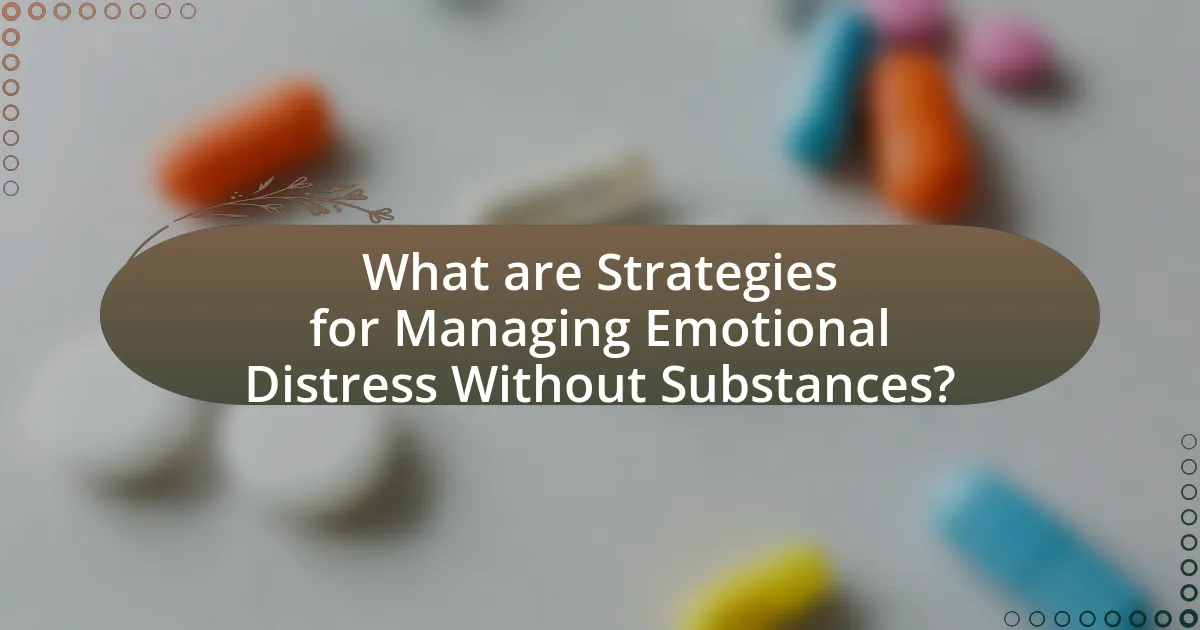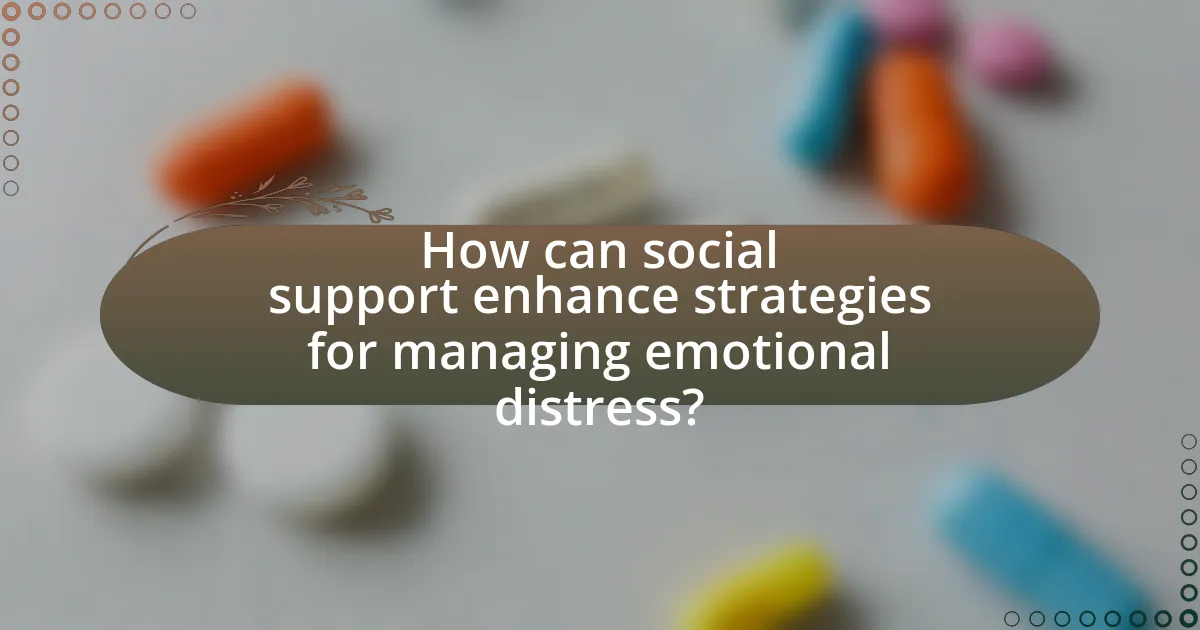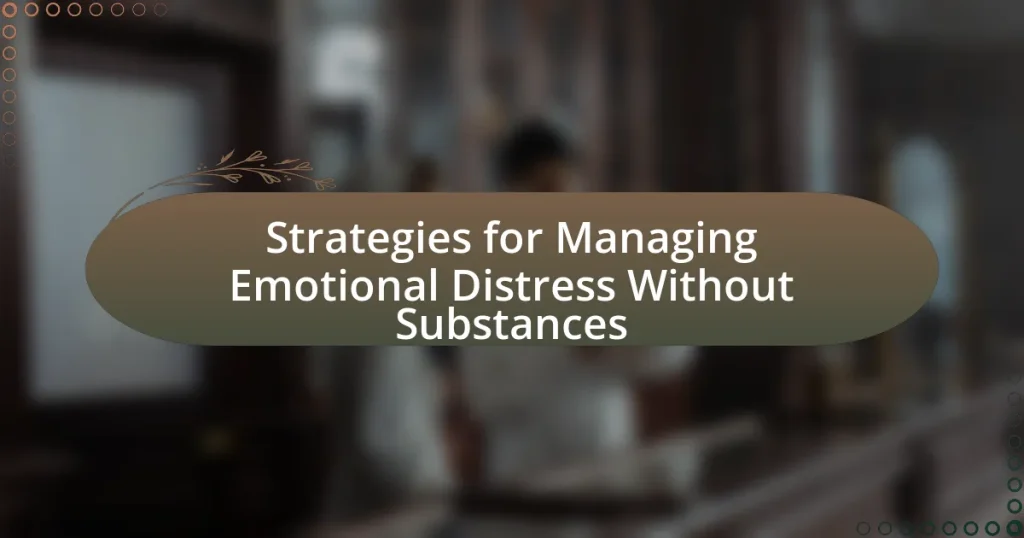The article focuses on strategies for managing emotional distress without the use of substances. It outlines various effective techniques, including mindfulness practices, physical exercise, cognitive-behavioral techniques, and the importance of social support. The article also discusses the common causes and manifestations of emotional distress, the risks associated with substance use for emotional relief, and how understanding emotional distress can improve management strategies. Additionally, it highlights the role of professional help in complementing self-management strategies and provides practical tips for individuals to enhance their emotional well-being.

What are Strategies for Managing Emotional Distress Without Substances?
Strategies for managing emotional distress without substances include practicing mindfulness, engaging in physical exercise, utilizing cognitive-behavioral techniques, and seeking social support. Mindfulness practices, such as meditation and deep-breathing exercises, have been shown to reduce anxiety and improve emotional regulation (Kabat-Zinn, 1990). Regular physical exercise releases endorphins, which can enhance mood and alleviate stress (Craft & Perna, 2004). Cognitive-behavioral techniques help individuals identify and challenge negative thought patterns, leading to improved emotional responses (Hofmann et al., 2012). Additionally, social support from friends and family can provide emotional comfort and practical assistance, which is crucial for coping with distress (Cohen & Wills, 1985).
How can understanding emotional distress improve management strategies?
Understanding emotional distress can significantly enhance management strategies by enabling tailored interventions that address specific emotional needs. When managers recognize the signs and sources of emotional distress, they can implement strategies such as active listening, empathy, and support systems that foster a healthier work environment. Research indicates that organizations that prioritize emotional well-being see a 20% increase in employee productivity and a 30% reduction in turnover rates, demonstrating the effectiveness of addressing emotional distress in management practices.
What are the common causes of emotional distress?
Common causes of emotional distress include trauma, loss, chronic stress, and mental health disorders. Trauma, such as experiencing abuse or witnessing violence, can lead to significant emotional pain. Loss, whether through death or separation, often triggers grief and sadness. Chronic stress from work, relationships, or financial issues can overwhelm individuals, leading to anxiety and depression. Additionally, mental health disorders like depression and anxiety can inherently cause emotional distress, affecting daily functioning and overall well-being. These factors are well-documented in psychological literature, highlighting their impact on emotional health.
How does emotional distress manifest in individuals?
Emotional distress manifests in individuals through a range of psychological and physical symptoms, including anxiety, depression, irritability, and changes in appetite or sleep patterns. These symptoms can lead to significant impairment in daily functioning, as evidenced by studies showing that individuals experiencing emotional distress often report decreased quality of life and increased difficulty in social and occupational settings. For instance, research published in the Journal of Affective Disorders indicates that emotional distress is closely linked to heightened levels of anxiety and depressive disorders, which can exacerbate physical health issues, such as chronic pain or fatigue.
Why is it important to manage emotional distress without substances?
Managing emotional distress without substances is crucial because it promotes healthier coping mechanisms and reduces the risk of substance dependency. When individuals rely on substances to cope with emotional pain, they may experience temporary relief but ultimately exacerbate their distress and create additional health issues, such as addiction or mental health disorders. Research indicates that non-substance-based strategies, such as therapy, mindfulness, and physical activity, can effectively reduce symptoms of emotional distress and improve overall well-being. For instance, a study published in the Journal of Affective Disorders found that cognitive-behavioral therapy significantly decreased anxiety and depression levels without the need for medication. Thus, managing emotional distress without substances fosters resilience and long-term emotional health.
What are the risks associated with substance use for emotional relief?
Substance use for emotional relief carries significant risks, including addiction, mental health deterioration, and physical health complications. Addiction can develop as individuals increasingly rely on substances to cope with emotional distress, leading to a cycle of dependence. Research indicates that approximately 21% of individuals who use substances for emotional relief may develop substance use disorders, which can exacerbate underlying mental health issues such as anxiety and depression. Additionally, substances can impair cognitive function and emotional regulation, resulting in increased vulnerability to stress and emotional instability. Physical health risks include cardiovascular problems, liver damage, and increased likelihood of accidents or injuries. These risks highlight the dangers of using substances as a coping mechanism for emotional distress.
How can non-substance strategies lead to healthier coping mechanisms?
Non-substance strategies can lead to healthier coping mechanisms by promoting resilience and emotional regulation through alternative methods such as mindfulness, exercise, and social support. These strategies encourage individuals to engage in activities that enhance mental well-being, reduce stress, and foster a sense of community. For instance, research published in the Journal of Clinical Psychology indicates that mindfulness practices can significantly decrease anxiety and improve emotional regulation, leading to more adaptive coping strategies. Additionally, physical exercise has been shown to release endorphins, which naturally elevate mood and reduce feelings of distress. By utilizing these non-substance approaches, individuals can develop more effective ways to manage their emotions, ultimately leading to healthier coping mechanisms.

What are the key non-substance strategies for managing emotional distress?
Key non-substance strategies for managing emotional distress include mindfulness, cognitive-behavioral techniques, physical exercise, social support, and creative expression. Mindfulness practices, such as meditation and deep breathing, help individuals focus on the present moment, reducing anxiety and stress. Cognitive-behavioral techniques involve identifying and challenging negative thought patterns, which can lead to improved emotional regulation. Regular physical exercise has been shown to release endorphins, enhancing mood and reducing feelings of distress. Social support from friends and family provides emotional comfort and practical assistance, which can alleviate feelings of isolation. Creative expression through art, music, or writing allows individuals to process emotions and can serve as a therapeutic outlet. These strategies are supported by research indicating their effectiveness in improving mental health outcomes.
How can mindfulness and meditation help in managing emotional distress?
Mindfulness and meditation can significantly help in managing emotional distress by promoting emotional regulation and reducing anxiety. Research indicates that mindfulness practices enhance awareness of thoughts and feelings, allowing individuals to respond to emotional distress with greater clarity and calmness. A study published in the journal “Psychological Science” by Zeidan et al. (2010) found that just a few sessions of mindfulness meditation can lead to reductions in anxiety and improvements in mood. Furthermore, mindfulness training has been shown to activate brain regions associated with emotional regulation, such as the prefrontal cortex, which helps individuals manage their emotional responses more effectively.
What techniques are effective in practicing mindfulness?
Effective techniques for practicing mindfulness include focused breathing, body scan meditation, and mindful observation. Focused breathing involves concentrating on the breath to anchor attention in the present moment, which has been shown to reduce anxiety and improve emotional regulation. Body scan meditation encourages awareness of physical sensations throughout the body, promoting relaxation and a deeper connection to one’s physical state. Mindful observation entails paying attention to the environment without judgment, enhancing awareness and appreciation of the present moment. Research indicates that these techniques can significantly decrease stress and improve overall mental well-being, as evidenced by studies published in journals such as “Mindfulness” and “The Journal of Clinical Psychology.”
How does meditation impact emotional regulation?
Meditation enhances emotional regulation by promoting mindfulness and reducing reactivity to emotional stimuli. Research indicates that regular meditation practice can lead to structural changes in the brain, particularly in areas associated with emotional processing, such as the prefrontal cortex and amygdala. A study published in the journal “Psychological Science” by Zeidan et al. (2010) found that participants who engaged in mindfulness meditation showed improved emotional regulation and reduced anxiety levels compared to those who did not meditate. This suggests that meditation fosters a greater awareness of emotional states, enabling individuals to respond to emotions more thoughtfully rather than reactively.
What role does physical activity play in emotional distress management?
Physical activity plays a significant role in managing emotional distress by reducing symptoms of anxiety and depression. Engaging in regular exercise stimulates the release of endorphins, which are chemicals in the brain that act as natural mood lifters. Research published in the Journal of Clinical Psychiatry indicates that individuals who participate in physical activity experience a 20-30% reduction in depressive symptoms. Additionally, a study from the American Journal of Preventive Medicine found that even moderate exercise can lead to improved mental health outcomes, highlighting the effectiveness of physical activity as a non-substance-based strategy for emotional distress management.
Which types of exercise are most beneficial for emotional health?
Aerobic exercises, such as running, swimming, and cycling, are most beneficial for emotional health. These activities increase the production of endorphins, which are chemicals in the brain that act as natural mood lifters. Research published in the Journal of Clinical Psychiatry indicates that regular aerobic exercise can significantly reduce symptoms of depression and anxiety. Additionally, strength training has also been shown to improve emotional well-being by enhancing self-esteem and reducing stress levels. A study from the American Journal of Lifestyle Medicine found that individuals engaging in regular strength training reported lower levels of anxiety and improved mood.
How does regular physical activity influence mood and stress levels?
Regular physical activity significantly improves mood and reduces stress levels. Engaging in exercise triggers the release of endorphins, which are chemicals in the brain that act as natural painkillers and mood elevators. Research published in the Journal of Clinical Psychiatry indicates that individuals who participate in regular physical activity experience lower levels of anxiety and depression compared to sedentary individuals. Additionally, a study by the American Psychological Association found that even short bouts of exercise can lead to immediate improvements in mood and reductions in stress. These findings demonstrate that consistent physical activity serves as an effective strategy for managing emotional distress without the use of substances.

How can social support enhance strategies for managing emotional distress?
Social support enhances strategies for managing emotional distress by providing individuals with resources, validation, and coping mechanisms. Research indicates that social connections can reduce feelings of isolation and increase resilience, which are crucial for emotional well-being. For instance, a study published in the Journal of Health and Social Behavior found that individuals with strong social networks reported lower levels of anxiety and depression, demonstrating the protective effects of social support. Furthermore, social support can facilitate access to information and strategies for coping, such as problem-solving techniques and emotional regulation skills, thereby improving overall mental health outcomes.
What types of social support are most effective?
Emotional support, informational support, and instrumental support are the most effective types of social support. Emotional support involves providing empathy, care, and reassurance, which has been shown to reduce feelings of loneliness and anxiety. Informational support includes offering advice, guidance, and resources, which can help individuals make informed decisions during distressing times. Instrumental support refers to tangible assistance, such as helping with tasks or providing financial aid, which can alleviate stressors directly. Research indicates that individuals who receive a combination of these support types report better mental health outcomes and coping abilities, as evidenced by studies published in journals like the Journal of Health and Social Behavior.
How can friends and family contribute to emotional well-being?
Friends and family contribute to emotional well-being by providing social support, which has been shown to reduce stress and enhance mental health. Research indicates that strong social connections can lead to lower rates of anxiety and depression, as well as improved coping mechanisms during difficult times. For instance, a study published in the journal “Psychological Science” found that individuals with supportive relationships reported higher levels of happiness and life satisfaction. Additionally, friends and family can offer practical assistance, emotional validation, and a sense of belonging, all of which are crucial for maintaining emotional stability.
What are the benefits of support groups in managing emotional distress?
Support groups provide emotional support, reduce feelings of isolation, and enhance coping strategies for individuals experiencing emotional distress. By sharing experiences and feelings in a safe environment, participants often find validation and understanding, which can significantly alleviate anxiety and depression. Research indicates that individuals who engage in support groups report improved mental health outcomes, including increased resilience and a greater sense of belonging. A study published in the Journal of Clinical Psychology found that participants in support groups experienced a 30% reduction in symptoms of depression and anxiety compared to those who did not participate. This evidence underscores the effectiveness of support groups in managing emotional distress.
How can professional help complement self-management strategies?
Professional help can enhance self-management strategies by providing expert guidance, tailored interventions, and accountability. Mental health professionals, such as therapists or counselors, can assess individual needs and recommend specific coping techniques that align with a person’s unique circumstances. Research indicates that combining self-management with professional support leads to improved outcomes; for instance, a study published in the Journal of Consulting and Clinical Psychology found that individuals who received therapy alongside self-help strategies reported greater reductions in anxiety and depression symptoms compared to those who relied solely on self-management. This collaborative approach ensures that individuals not only learn effective self-management techniques but also receive ongoing support and adjustments to their strategies as needed.
What types of professionals can assist in managing emotional distress?
Mental health professionals such as psychologists, psychiatrists, and licensed clinical social workers can assist in managing emotional distress. Psychologists provide therapy and counseling to help individuals understand and cope with their emotions. Psychiatrists can prescribe medication and offer medical evaluations for mental health conditions. Licensed clinical social workers offer support and resources for individuals facing emotional challenges. Research indicates that therapy can significantly reduce symptoms of emotional distress, with studies showing that cognitive-behavioral therapy (CBT) is effective in treating anxiety and depression, which are common forms of emotional distress.
How can therapy techniques aid in developing coping strategies?
Therapy techniques can significantly aid in developing coping strategies by providing structured methods for individuals to understand and manage their emotions. Cognitive Behavioral Therapy (CBT), for example, teaches clients to identify negative thought patterns and replace them with healthier ones, which enhances emotional regulation. Research indicates that individuals who engage in CBT report improved coping skills and reduced symptoms of anxiety and depression, as evidenced by a meta-analysis published in the Journal of Consulting and Clinical Psychology, which found that CBT is effective in fostering adaptive coping mechanisms. Additionally, mindfulness-based therapies encourage present-moment awareness, helping individuals to respond to stressors more effectively rather than reactively. This combination of cognitive restructuring and mindfulness practices equips individuals with practical tools to navigate emotional distress without resorting to substances.
What practical tips can individuals use to manage emotional distress without substances?
Individuals can manage emotional distress without substances by employing techniques such as mindfulness meditation, physical exercise, and engaging in creative activities. Mindfulness meditation has been shown to reduce symptoms of anxiety and depression by promoting present-moment awareness and emotional regulation. Research published in JAMA Internal Medicine indicates that mindfulness practices can lead to significant improvements in mental health. Physical exercise, including activities like walking or yoga, releases endorphins, which are natural mood lifters, and has been linked to reduced feelings of stress and anxiety. Engaging in creative activities, such as painting or writing, allows for emotional expression and can serve as a therapeutic outlet, enhancing overall well-being.
